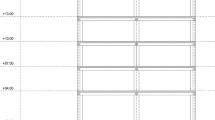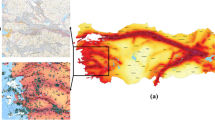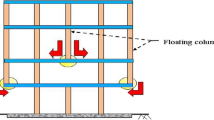Abstract
A new method is proposed to evaluate the seismic stability of a rigid retaining wall undergoing translation or rotational failure. In the present method, strain-dependent dynamic properties are used to assess the seismic stability of rigid retaining walls against sliding and overturning failure conditions. The effect of foundation soil properties on the stability of retaining walls is also considered. From the parametric study, it is observed that the foundation soil properties have a significant effect on both sliding and rotational stability of rigid retaining walls. This can be attributed to the use of strain-dependent dynamic properties and the consideration of foundation soil properties. The predictions of the proposed method are compared and verified against the results from other methods proposed in the past. The percentage increase in the results compared to the existing literature is a maximum of 10 and 28% for rigid (bedrock) and flexible (sand deposit) foundation, respectively.









Similar content being viewed by others
Abbreviations
- ah, ahf, ahw :
-
Horizontal seismic acceleration in the backfill, foundation and wall, respectively
- b :
-
b w /H
- b w :
-
Top width of the retaining wall
- CI, CIE(t):
-
Static and seismic wall inertia factors
- CR, CRD(t):
-
Static and seismic wall rotational factors
- Db, Df, Dw :
-
Damping Ratio of the backfill soil, foundation soil and wall material respectively
- Fb, Nb :
-
Horizontal and vertical components of reaction on the base of the wall
- FT, FI, FR :
-
Soil active thrust, wall inertia and wall rotational factor, respectively
- FWS, FWR :
-
Combined dynamic factor against sliding and rotational failures, respectively
- g :
-
Acceleration due to gravity
- H, Hf :
-
Height of the retaining wall and foundation depth, respectively
- Ka, Kae (t):
-
Static and seismic active earth pressure coefficients
- \(k^{*} , k_{f}^{*}\) :
-
Complex wave number of the backfill material and foundation soil, respectively
- k h :
-
Horizontal seismic acceleration coefficient at the bedrock
- ms (z), mw (z):
-
Elemental mass of the soil wedge and wall, respectively
- Pae (t):
-
Total active earth thrust
- Qhb (t), Qhw (t):
-
Horizontal inertia forces acting in the failure wedge and wall, respectively
- r c :
-
Radial distance between the centroid of the wall and rotation centre E
- t :
-
Time
- T :
-
Period of lateral shaking
- u hb :
-
Displacement in the bedrock
- uh, uhf :
-
Horizontal displacement in the backfill and foundation soil, respectively
- Vs, Vsf, Vsw :
-
Shear wave velocity of the backfill, foundation soil and wall material, respectively
- W w :
-
Weight of the wall
- Wws, static, Wwr, static :
-
Weight of the wall required for equilibrium against sliding and rotational failure under static conditions, respectively
- Wws (t), Wwr (t):
-
Weight of the wall required for equilibrium against sliding and rotational failure under seismic conditions, respectively
- W s :
-
Weight of the failure wedge
- z, zf :
-
Depth from the top of the wall or backfill and foundation layer, respectively
- α :
-
Angle of the failure plane with respect to horizontal
- γs, γsf :
-
Shear strain in the backfill and foundation soil, respectively
- γb, γf, γw :
-
Unit weight of the backfill, foundation soil and wall material, respectively
- ρb, ρf :
-
Mass density of the backfill and foundation soil, respectively
- δ :
-
Wall friction angle
- \(\eta_{0}\) :
-
Angle of inclination of radial distance between centroid and rotation centre, E with horizontal
- θ :
-
Wall inclination angle
- ϕ :
-
Soil friction angle
- ϕ b :
-
Wall base friction angle
- ω :
-
Angular frequency of motion = 2π/T
- λ :
-
Impedance ratio
References
Basha BM, Babu GS (2010) Optimum design of bridge abutments under high seismic loading using modified pseudo-static method. J Earthq Eng 14(6):874–897
Baziar MH, Shahnazari H, Rabeti Moghadam M (2013) Sliding stability analysis of gravity retaining walls using the pseudo-dynamic method. Proc Inst Civil Eng Geotech Eng 166(4):389–398
Bellezza I (2014) A new pseudo-dynamic approach for seismic active soil thrust. Geotech Geol Eng 32(2):561–576
Bellezza I (2015) Seismic active soil thrust on walls using a new pseudo-dynamic approach. Geotech Geol Eng 33(4):795–812
Cai Y, Chen Q, Zhou Y, Nimbalkar S, Yu J (2016) Estimation of passive earth pressure against rigid retaining wall considering arching effect in cohesive-frictional backfill under translation mode. Int J Geomech 17(4):04016093. https://doi.org/10.1061/(ASCE)GM.1943-5622.0000786
Caltabiano S, Cascone E, Maugeri M (2000) Seismic stability of retaining walls with surcharge. Soil Dyn Earthq Eng 20(5–8):469–476
Choudhury D, Nimbalkar S (2006) Pseudo-dynamic approach of seismic active earth pressure behind retaining wall. Geotech Geol Eng 24(5):1103–1113
Choudhury D, Nimbalkar S (2008) Seismic rotational displacement of gravity walls by pseudodynamic method. Int J Geomech 8(3):169–175
Conti R, Viggiani GMB, Cavallo S (2013) A two-rigid block model for sliding gravity retaining walls. Soil Dyn Earthq Eng 55:33–43
Ghanbari A, Ahmadabadi M (2010) Pseudo-dynamic active earth pressure analysis of inclined retaining walls using horizontal slices method. Sci Iran Trasc A Civil Eng 17(2):118–130
Ghosh S, Sharma RP (2012) Seismic active earth pressure on the back of battered retaining wall supporting inclined backfill. Int J Geomech 12(1):54–63
Giri D (2011) Pseudo-dynamic approach of seismic earth pressure behind cantilever retaining wall with inclined backfill surface. Geomech Eng 3(4):255–266
Handy RL (1985) The arch in soil arching. Journal of Geotechnical Engineering 111(3):302–318
Huang CC, Wu SH, Wu HJ (2009) Seismic displacement criterion for soil retaining walls based on soil shear strength mobilization. J Geotech Geoenviron Eng 135(1):74–83
Jo SB, Ha JG, Lee JS, Kim DS (2017) Evaluation of the seismic earth pressure for inverted T-shape stiff retaining wall in cohesionless soils via dynamic centrifuge. Soil Dyn Earthq Eng 92:345–357
Jung C, Bobet A, Fernández G (2010) Analytical solution for the response of a flexible retaining structure with an elastic backfill. Int J Numer Anal Methods Geomech 34(13):1387–1408
Kolathayar S, Ghosh P (2009) Seismic active earth pressure on walls with bilinear backface using pseudo-dynamic approach. Comput Geotech 36(7):1229–1236
Kramer SL (1996) Geotechnical earthquake engineering. Dorling Kindersley Pvt. Ltd., Noida
Lin YL, Leng WM, Yang GL, Zhao LH, Li L, Yang JS (2015) Seismic active earth pressure of cohesive-frictional soil on retaining wall based on a slice analysis method. Soil Dyn Earthq Eng 70:133–147
Mylonakis G, Kloukinas P, Papantonopoulos C (2007) An alternative to the Mononobe-Okabe equations for seismic earth pressures. Soil Dyn Earthq Eng 27(10):957–969
Nakamura S (2006) Reexamination of Mononobe-Okabe theory of gravity retaining walls using centrifuge model tests. Soils Found 46(2):135–146
Nimbalkar S, Annapareddy VSR, Pain A (2018) A simplified approach to assess seismic stability of tailings dams. J Rock Mech and Geotech Eng 10(6):1082–1090
Pain A, Choudhury D, Bhattacharyya SK (2015) Seismic stability of retaining wall-soil sliding interaction using modified pseudo-dynamic method. Geotechnique Letters 5(1):56–61
Pain A, Choudhury D, Bhattacharyya SK (2016) Computation of rotational displacements of gravity retaining walls by pseudo-dynamic method. In: proceedings of the 4th geo-china international conference: sustainable civil infrastructures: innovative technologies for severe weathers and climate changes shandong, China, pp 124–132
Pain A, Chen QS, Nimbalkar S, Zhou Y (2017a) Evaluation of seismic passive earth pressure of inclined rigid retaining wall considering soil arching effect. Soil Dyn Earthq Eng 100:286–295
Pain A, Choudhury D, Bhattacharyya SK (2017b) Seismic rotational stability of gravity retaining walls by modified pseudo-dynamic method. Soil Dyn Earthq Eng 94:244–253
Pain A, Annapareddy VSR, Nimbalkar S (2018) Seismic active earth thrust on rigid retaining wall using strain dependent dynamic properties. Int J Geomech 18(12):06018034
Psarropoulos PN, Klonaris G, Gazetas G (2005) Seismic earth pressures on rigid and flexible retaining wall. Soil Dyn Earthq Eng 25(7–10):795–809
Rao P, Chen Q, Zhou Y, Nimbalkar S, Chiaro G (2015) Determination of active earth pressure on rigid retaining wall considering arching effect in cohesive backfill soil. Int J Geomech. https://doi.org/10.1061/(ASCE)GM.1943-5622.0000589
Richards R, Elms DG (1979) Seismic behaviour of gravity retaining walls. J Geotech Eng Div 105(4):449–464
Seed HB, Idriss IM (1970) Soil moduli and damping factors for dynamic response analysis, Report EERC 70-10. University of California, Earthquake Engineering Research Centre, Berkeley
Shukla SK, Bathurst RJ (2012) An analytical expression for the dynamic active thrust from c–ϕ soil backfill on retaining walls with wall friction and adhesion. Geomech Eng 4(3):209–218
Steedman RS, Zeng X (1990) The influence of phase on the calculation of pseudo-static earth pressure on a retaining wall. Géotechnique 40(1):103–112
Whitman RV, Liao S (1985) Seismic design of gravity retaining walls. In: Proceedings of 8th world conference on earthquake engineering, San Francisco 3, pp 533–540
Zeng X, Steedman RS (2000) Rotating block method for seismic displacement of gravity walls. J Geotech Geo-environ Eng 126(8):709–717
Zhou YT, Chen QS, Chen FQ, Xue XH, Basack S (2018) Active earth pressure on translating rigid retaining structures considering soil arching effect. Eur J Environ Civil Eng 22(8):910–926. https://doi.org/10.1080/19648189.2016.1229225
Author information
Authors and Affiliations
Corresponding author
Additional information
Publisher's Note
Springer Nature remains neutral with regard to jurisdictional claims in published maps and institutional affiliations.
Rights and permissions
About this article
Cite this article
Nimbalkar, S., Pain, A. & Annapareddy, V.S.R. A Strain Dependent Approach for Seismic Stability Assessment of Rigid Retaining Wall. Geotech Geol Eng 38, 6041–6055 (2020). https://doi.org/10.1007/s10706-020-01412-4
Received:
Accepted:
Published:
Issue Date:
DOI: https://doi.org/10.1007/s10706-020-01412-4




